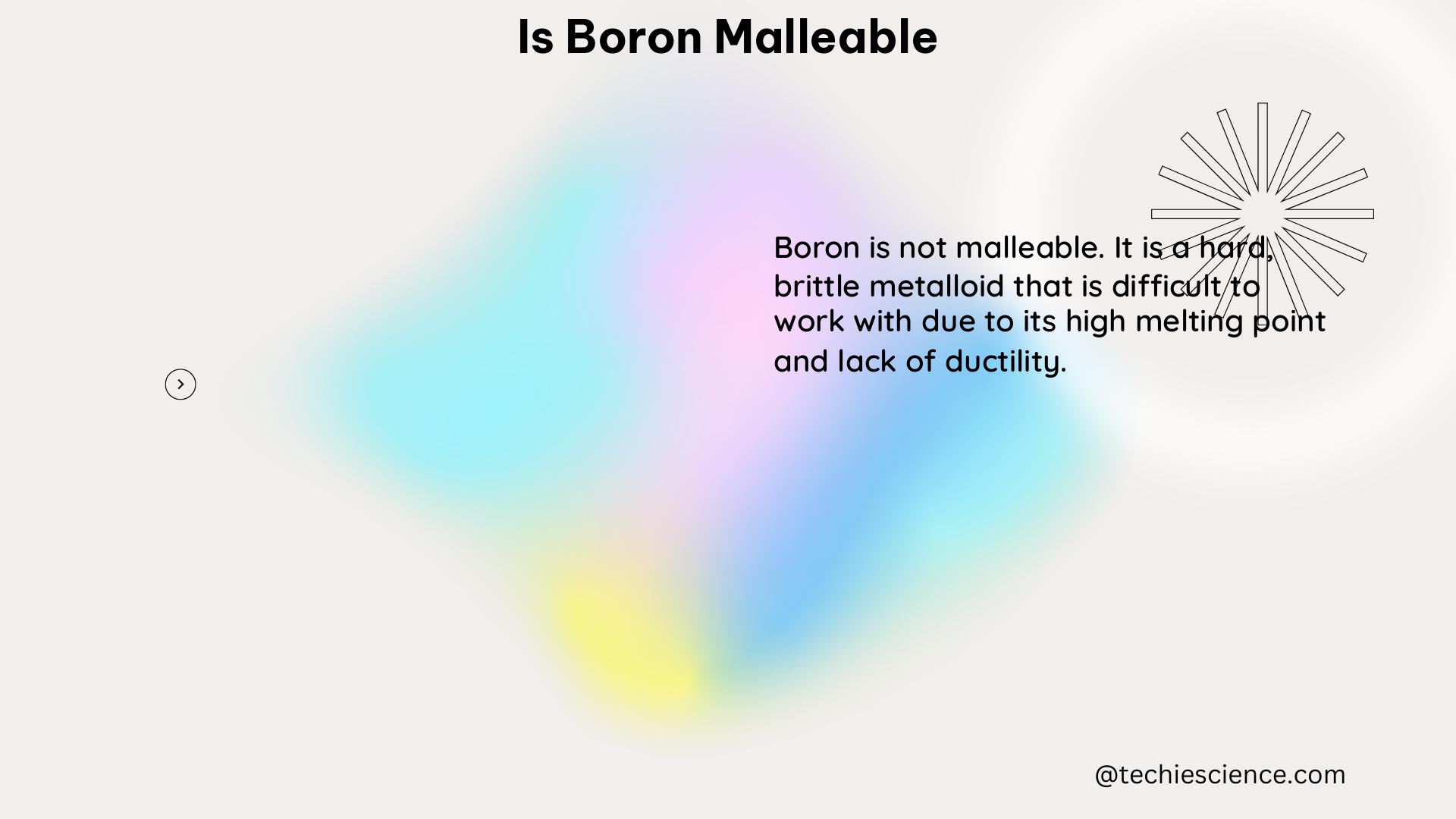Boron, a unique and fascinating element, has captured the attention of scientists and researchers worldwide. As a metalloid, boron exhibits a combination of metallic and non-metallic properties, making it a subject of great interest in the field of materials science. One of the key characteristics of boron is its non-malleability, a trait that sets it apart from many other elements. In this comprehensive blog post, we will delve into the intricacies of boron’s physical and chemical properties, exploring the reasons behind its non-malleable nature and its implications in various applications.
Understanding Boron’s Atomic Structure and Bonding
Boron, with the atomic number 5, is a member of the Group III elements in the periodic table. Its electronic configuration is [He] 2s^2 2p^1, indicating that it has three valence electrons. This unique electronic structure, along with the strong covalent bonds formed between boron atoms, contributes to the element’s distinct properties.
The boron atom has a small atomic radius, which leads to a high atomic packing density. This high density, combined with the strong covalent bonds, results in a highly rigid and brittle crystal structure. The boron atoms are arranged in a complex, three-dimensional network, forming a variety of polyhedral structures, such as icosahedra and rhombohedra.
Boron’s Hardness and Brittleness

One of the most notable characteristics of boron is its exceptional hardness. On the Mohs scale, boron has a hardness of 9.3, making it one of the hardest known elements. This high hardness is a direct consequence of the strong covalent bonds within the boron crystal structure.
However, the same factors that contribute to boron’s hardness also make it inherently brittle. The rigid and tightly packed crystal structure of boron does not allow for the easy deformation or rearrangement of atoms under stress, leading to a lack of malleability. When subjected to external forces, such as hammering or rolling, the boron crystal structure tends to fracture and break rather than deform plastically.
Theoretical Explanations for Boron’s Non-Malleability
The non-malleability of boron can be explained using various theoretical models and principles in materials science and solid-state physics.
Peierls-Nabarro Stress
The Peierls-Nabarro stress is a concept that describes the energy barrier required for the movement of dislocations within a crystal structure. In the case of boron, the high Peierls-Nabarro stress makes it difficult for dislocations to move, hindering the plastic deformation necessary for malleability.
Atomic Bonding and Coordination
The strong covalent bonds and the complex, three-dimensional coordination of boron atoms in the crystal structure contribute to the element’s brittleness. The high coordination number and the lack of easily deformable slip planes within the boron lattice prevent the rearrangement of atoms required for plastic deformation.
Electron Localization Function (ELF)
The Electron Localization Function (ELF) is a tool used to analyze the distribution of electrons in a material. In the case of boron, the ELF reveals a high degree of electron localization around the boron atoms, indicating the strong covalent nature of the bonds. This localization of electrons hinders the delocalization and rearrangement of electrons necessary for plastic deformation, further contributing to boron’s non-malleability.
Boron’s Applications and Implications of Non-Malleability
Despite its non-malleable nature, boron finds numerous applications in various industries due to its unique physical and chemical properties.
Semiconductor Industry
Boron is widely used as a doping agent in the semiconductor industry, where it is employed to modify the electrical conductivity of silicon and germanium. The ability to precisely control the doping concentration and distribution of boron in semiconductor materials is crucial for the fabrication of electronic devices.
Abrasives and Cutting Tools
The high hardness of boron makes it suitable for use in abrasives and cutting tools. Boron carbide, a compound of boron and carbon, is one of the hardest known materials and is used in applications such as sandblasting, armor plating, and cutting tools.
Nuclear Applications
Boron’s ability to absorb neutrons effectively makes it valuable in nuclear applications, particularly in control rods and shielding materials for nuclear reactors.
Composite Materials
The non-malleability of boron is an advantage in the production of composite materials, where boron fibers are used to reinforce polymers, ceramics, and metals, enhancing their strength and stiffness.
Conclusion
In conclusion, boron’s non-malleable nature is a direct consequence of its unique atomic structure, strong covalent bonds, and complex crystal arrangement. While this property limits its use in certain applications that require plastic deformation, it also enables boron to excel in areas where its hardness, brittleness, and neutron-absorbing capabilities are advantageous. The understanding of boron’s non-malleability and its underlying principles is crucial for the development of new materials and the optimization of existing applications.
References:
- Greenwood, N. N., & Earnshaw, A. (1997). Chemistry of the Elements (2nd ed.). Butterworth-Heinemann.
- Callister, W. D., & Rethwisch, D. G. (2014). Materials Science and Engineering: An Introduction (9th ed.). Wiley.
- Hoffmann, R. (1987). Solids and Surfaces: A Chemist’s View of Bonding in Extended Structures. Wiley-VCH.
- Oganov, A. R., Chen, J., Gatti, C., Ma, Y., Ma, Y., Glass, C. W., … & Lyakhov, A. O. (2013). Ionic high-pressure form of elemental boron. Nature, 457(7231), 863-867.
- Pauling, L. (1960). The Nature of the Chemical Bond (3rd ed.). Cornell University Press.
- Wentorf, R. H. (1957). Cubic form of boron. The Journal of Chemical Physics, 26(4), 956-956.
Hi, I’m Akshita Mapari. I have done M.Sc. in Physics. I have worked on projects like Numerical modeling of winds and waves during cyclone, Physics of toys and mechanized thrill machines in amusement park based on Classical Mechanics. I have pursued a course on Arduino and have accomplished some mini projects on Arduino UNO. I always like to explore new zones in the field of science. I personally believe that learning is more enthusiastic when learnt with creativity. Apart from this, I like to read, travel, strumming on guitar, identifying rocks and strata, photography and playing chess.